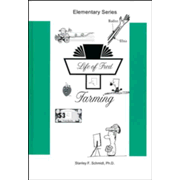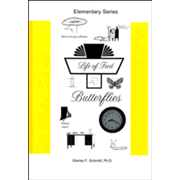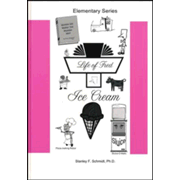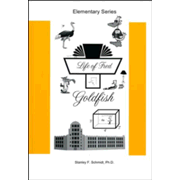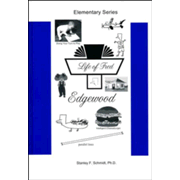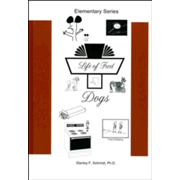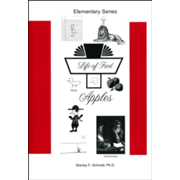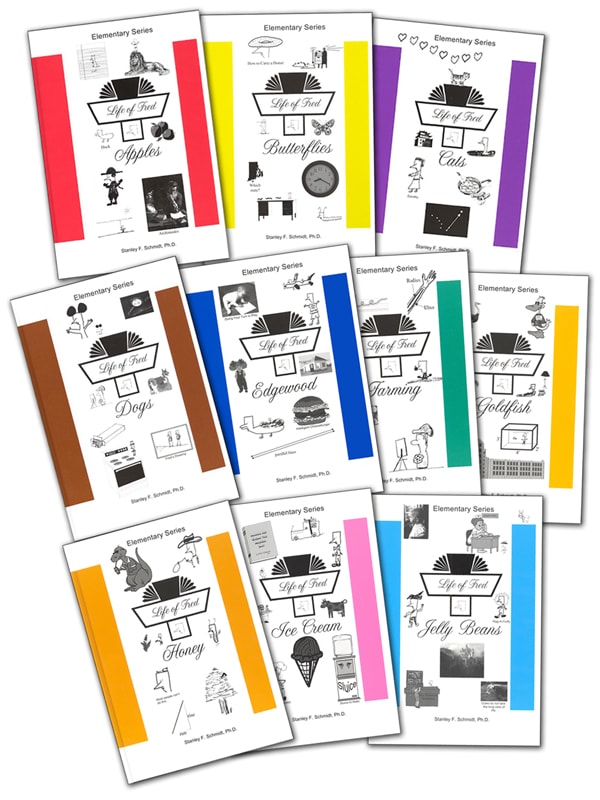The Life of Fred series has books for the elementary grades through high school (or even college). Reviews of Fractions (for fifth grade or above) through Trigonometry are in a separate review. I repeat some of my general observations about the series in both reviews.
Two features immediately make this appealing to many families: low cost and courses designed for independent study. But there's much more to the Life of Fred books!
The books are written by Dr. Stanley Schmidt, a retired math teacher who loves math and wants to share his enthusiasm with students. Part of his strategy is to build his math books around the adventures of Fred, a five-year-old genius who is a math teacher at KITTTENS University. The stories shift from silly to serious, outlandish to edgy. Some parents might be uncomfortable with instances such as the story where Fred is tricked into paying $100 for a snotty handkerchief in Goldfish. The Life of Fred books are likely to be very appealing to learners who work better with stories and situations to help them visualize math problems.
Fred's adventures are the jumping off point for math lessons (e.g., Fred plays with his food and creates a polygon), or Fred might be pondering something mathematical, or teaching, or discussing a math topic with friends or students. All of this makes these texts much more user-friendly than most others. It also means that it takes longer to get through the mathematical material. Surprisingly, the storyline and discursions are not used to dumb down the courses.
Each lesson teaches a concept, albeit sometimes in a roundabout fashion through the story. There's a "Your Turn to Play," a short set of practice problems with complete answers and explanations if needed. Sometimes, extra entertainment or information appears in the answer key. Your Turn to Play always shows up on a right-hand page, and the answers are on the following page. (If you think your child might quickly flip to see answers in advance, try paper clipping the pages together.)
Throughout the series, Dr. Schmidt tries to teach for conceptual understanding rather than memorization of formulas and strategies. The practical application of a math concept is often seen before students learn how to solve the problem. Students are likely to begin thinking about math more like solving puzzles or critical thinking exercises than lists of problems to solve. The story of Fred is an important part of this approach. While it sometimes meanders into entertainment unrelated to the math topic at hand, most of the time it stimulates students to consider how math might be used to deal with a real-life situation. Some of the excursions are rather funny—maybe more so for adults than children. For example, after Fred’s ATM access code gets stolen and his checking account cleaned out, he realizes he has no budget for buying books. He imagines going without reading for three days:
This was too horrible to contemplate. Fred had once been at a lunch with a bunch of adults who were in the three-days-without-reading category. Their conversation was limited to: (1) My trip to Arizona. A complete description of all the bad things that happened on that trip. (2) The weather. (3) What I saw on television. (4) My kids. (5) Sports. (6) My health problems (Dogs, p. 75).
The storyline might be interesting enough to students that they plow through the books more quickly than you might imagine. However, children's interest spans vary, so it is difficult to predict how long it might take a child to complete any of the books.
One potential drawback I see in the elementary books is that the discursions and extraneous information might be overwhelming for some students, especially when Dr. Schmidt throws in something entirely new, such as a calculus equation, with no explanation.
The ten texts for the elementary series and the three texts for the intermediate series will generally be used for grades one through four. They are unusually titled with no grade level indicators, but all texts should be used in alphabetical order. Apples, Butterflies, Cats, Dogs, Edgewood, Farming, Goldfish, Honey, Ice Cream, and Jelly Beans comprise the elementary series. The intermediate series—Kidneys, Liver, and Mineshaft—should be used after the elementary books and prior to Fractions. Life of Fred: Fractions and Life of Fred: Decimals and Percents will be used in the fifth and sixth grades. However, many of the topics covered in the intermediate series, topics such as exponents and functions in Kidneys, should make them suitable for older students as well.
All students should work through the entire series to follow the storyline and also because concepts taught in earlier books are frequently used in subsequent books. For example, the concept of functions is taught a few times in Dogs, then functions show up in problems beginning in chapter three of Edgewood without further instruction. Students might complete two or more books per year, especially for those past kindergarten and first grade. Older students, such as a fourth grader just starting the series, might breeze through many of the books quickly to get up to a challenging level.
The progression and method of learning are unusual, and you might feel that your child is not doing enough math. But supplementing might not be necessary. If you want additional problem-solving practice, consider using games, manipulatives, or a creative problem-solving workbook rather than a traditional workbook. Some homeschoolers will still want to use something more traditional as did one of my readers, Robin Dickinson. You can read her suggestion at the end of the review.
As I reviewed Life of Fred, I spotted a few religious references that imply that the author has a Christian worldview, but I didn't find any overtly religious statements.
In spite of their low cost, all of the Life of Fred texts are hardcover books, printed in black and white with clip art and line-drawn illustrations. Answer keys are included within the books, so there's nothing extra you need to purchase. In addition, the texts are non-consumable and might be used again for subsequent students.
Following are details regarding most of these books:
Apples
Before beginning Apples, students should have an understanding of the concept of addition and the symbols used in addition problems. For example, they should be able to “read” and understand “5 + 2 = 7.” This text, like the others, concentrates on concepts rather than computation practice and drill. Consequently, it teaches about the family of facts that add up to 7, but it doesn’t cover all the number families up to 7. It teaches the commutative property (without using that term), the concept adding x’s, counting by fives, counting by hundreds, money, time telling, sets, geometric shapes, cardinal numbers, days of the week and months, and the concept of zero. Along the way, students are introduced to other topics like the letters of the Greek alphabet, Archimedes, and compartmentalization on ships like the Titanic.
Butterflies
Butterflies adds the family of math facts that add up to nine, both addition and subtraction. It expands on many concepts introduced in the first book, especially identifying and working with large numbers and time telling. Students are introduced to concepts such as collinear points, infinite sets, some measurement equivalents, and counting by twos. You might have to explain some things that come up in the book such as negative temperatures. (You might want to teach other math fact families on your own at this point if it seems useful.)
Cats
Cats introduces the concepts of fractions, the metric system, and prime numbers. It continues basic math with more addition and subtraction; counting by twos, threes, and fives; patterns; angles; time telling; the concept of cardinality; measurement; place value; and representation of place value with small squares. The concept of carrying is very briefly introduced through pictures of arrays of small squares. Students might need a little more help to add 1 + 9999999 in a problem in chapter twelve. They’ve seen that 1 + 99 = 100, but they might not have grasped the full concept of carrying.
Dogs
Dogs continues with more difficult addition, but mathematical thinking continues to be the main topic. Students work with algebraic expressions, becoming increasingly familiar with “x” in equations. The concept of multiplication is introduced as Fred figures out that shots for the 30 dogs he wants to rescue will cost $10 each. Carrying is taught at the end of this book. Interestingly, this book introduces the concept of functions, working on it through a number of lessons.
Edgewood
While continuing to expand upon concepts previously taught, this text adds concepts such as the median average, bar graphs, the “>” symbol, percent (without applying multiplication), matrices, geometry (e.g., concurrent lines), and three-addend column addition with carrying.
Farming
Borrowing and multiplication show up in Farming along with concepts such as the union of sets, the circumference of a circle, natural and whole numbers, domains and codomains, and pi (π).
Goldfish
Goldfish continues to build upon previously taught concepts, then goes much further with multiplication (up to multiplying by 10 or 100 but otherwise only by single-digit multipliers), addition with decimal points, estimation, cubic measurement, and area.
Honey
Honey challenges students to master the multiplication facts using flash cards that you make or purchase. It also teaches division all the way through long division and remainders. Fractions are taught along with concepts like time zones, distance/rate/time problems (d = rt), and the slope formula.
I don't have details for Ice Cream, Jelly Beans, Kidneys, Liver, or Mineshaft.
Summary
It is difficult to convey the full flavor of these texts in a review, but Dr. Schmidt does a marvelous job of helping students see the real value and applications of math. Sample pages are available on the publisher's website, so you can check out this unusual math series to see if it's right for your children.
See my review of "upper level" Life of Fred texts by clicking here.
A helpful comment from Robin Dickinson:
I wanted to make a suggestion about Life of Fred (which we tried thanks to you and we love). We are combining it with Professor B Math. My son progressed easily through Apples and Butterflies but then got bogged down in Cats because of all the arithmetic concepts. So we stopped and reread Apples and Butterflies while working through Professor B. I would not consider Professor B a complete curriculum as it is just arithmetic (and eventually algebra) but it is great combined with Fred (which frankly skims over a lot of the basic arithmetic in favor of mathematic thinking and the wide variety of math concepts such as geometry, time telling, sets, etc).
My son has no interest in doing practice problems but at the same time can't just memorize flat out the way I could. Professor B takes a really unique approach. For instance, to memorize the lower addition facts, we started with a game that cemented which pairs of numbers go together (so for adding to ten that would be nine-one, eight-two, seven-three, etc). The chart with the numbers on it is gradually erased until the student is working entirely from memory. Once that is solid, you start moving on to all the associated addition and subtraction facts. It kind of reminds me of All About Spelling for math in that it groups like concepts together, teaches explicitly, avoids all the annoying worksheets I hated as a kid, and allows you to move as quickly or slowly as is comfortable for your student.
We really love Fred and if we had to pick just one math curriculum, it would be Fred, but the combination of Fred and Professor B is amazing!











